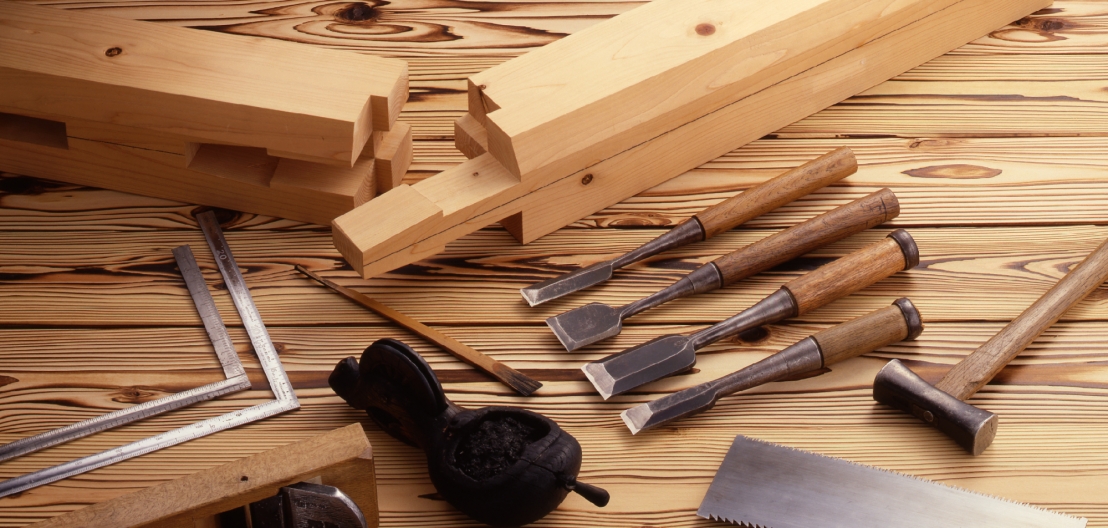The Tradition and Craftsmanship of Japanese Carpentry
Beyond the Craft
With the advent of revolutionary changes brought on by the Meiji period (1868-1912), after centuries of being veiled in mystery, Japanese culture finally became accessible and instantly fascinated the West with its profoundly thought-out beauty. Soaked with philosophy, the island country’s models of aesthetics irreversibly filtered into the awareness of those creating European art, and the birth of modern thought on shaping the human environment turned Westerners’ attention toward Far Eastern building construction.
The great fathers of modernism, Frank Lloyd Wright (1905), Bruno Taut (1933), Walter Gropius (1954), and Le Corbusier (1955), successively visited the interiors of the Katsura Imperial Villa (
Katsura Rikyū) near Kyoto to take an admiring look at the proportions, the organization of the plan, and the modular structure of the building. Those designers of the modern order subsequently utilized the formal and spatial solutions that they had observed there by integrating them into their sometimes utopian visions of new ways of residing. By contrast, however, what was decisive for the essence of Japanese architecture did not derive from a fascination with modernity or a desire for revolutionary change. Carefully cultivated, the centuries-old tradition of Japanese carpentry, which is filled with reverence for the material and its natural source, as well as the work itself, guaranteed a quality of the craft that had no match anywhere else in the world.
The Japanese idea of sustaining the tradition that is constitutive for national identity has its excellent institutional concretization in the Takenaka Carpentry Tools Museum in Kobe. It is the exquisitely fulfilled mission of this institution that enables the current generations of Japanese people not just to learn about and admire methods from the past but also to understand their staggering potential for planning a more sustainable environment, both today and in the future. With vigorous momentum, a local institution concerned with a narrowly defined, specialized field has been successfully disseminating the craft’s achievements in the West as well. It is the collaboration between the Takenaka Carpentry Tools Museum and the Manggha Museum of Japanese Art and Technology that has afforded the public in Poland an opportunity to admire the extraordinary craftsmanship of this unique carpentry.
In the exhibition in Kraków, the collection of objects proposed by the team of the Museum in Kobe has been organized into eight sections seamlessly morphing into one another. The technical and aesthetic narrative begins with the ur-source of material culture, which is the eternal and powerful nature. Then, following the achievements of architecture, the ritual process of its production, the spiritual dimension of the natural materials used, and the intricate craftsmanship of the tools, methods of processing and construction, this multi-faceted presentation culminates in an exemplification of a beauty that results not from a spontaneous creative act but from well-thought-out and organized work.
Especially in the case of Japanese crafts and applied arts, one ought to look inquisitively beyond the obvious and directly perceivable. Much can and should be said about the Japanese carpenters’ matchless manual skills, precision in planning and execution, perfectly designed tools, always ready for use, and the aesthetics that springs up unexpectedly in places whose function seems purely technical. Material culture, however, flourishes only when enhanced with profounder values, and these usually stem from spiritual or philosophical systems. It is therefore not insignificant that this exhibition features examples of sacred buildings from various religious backgrounds, accessories used in builders’ rites, and a teahouse (
chashitsu), a structure that forms a compound foreign to Europeans by fusing the quotidian physicality of austere materials with the spiritual in the tea ceremony –
chanoyu.
Tangible materiality commands tremendous respect in Japan, and is often associated with the sacred sphere, as it derives from nature, whose world has for centuries been filled with supernatural deities. The amalgamation of the purely technical with the spiritual and ritual aspects of the knowledge that has been passed from generation to generation has ensured the continuance of this splendid tradition, which today we, the people of the West, can draw upon as well.
Dominik Lisik
